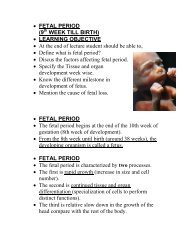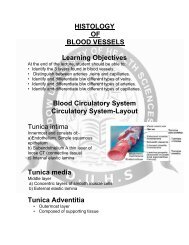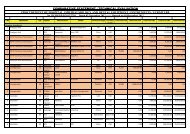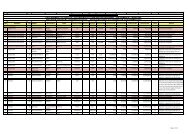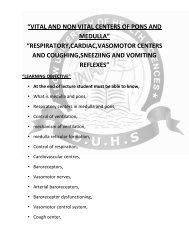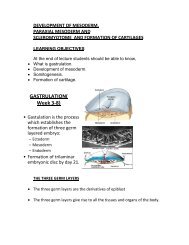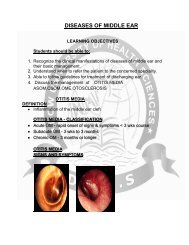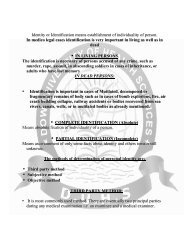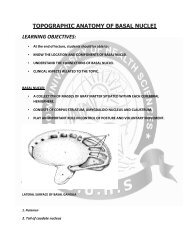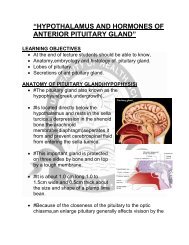morphological changes of reversible injury
morphological changes of reversible injury
morphological changes of reversible injury
You also want an ePaper? Increase the reach of your titles
YUMPU automatically turns print PDFs into web optimized ePapers that Google loves.
MORPHOLOGICAL ALTERATIONS<br />
IN CELL INJURY<br />
LEARNING OBJECTIVES:<br />
At the end <strong>of</strong> lecture students should be able to:<br />
Differentiate between Necrosis and Apoptosis.<br />
Describe the microscopic morphology <strong>of</strong> Reversible <strong>injury</strong>.<br />
Describe the nuclear and cytoplasmic features <strong>of</strong> necrosis.<br />
Define and briefly describe the patterns <strong>of</strong> Tissue Necrosis<br />
Differentiate B/W APOPTOSIS AND NECROSIS<br />
APOPTOSIS<br />
Chromatin condensation<br />
Cell shrinkage<br />
Preservation <strong>of</strong> organelles<br />
and cell membranes<br />
Rapid engulfment by<br />
neighboring cells<br />
preventing inflammation<br />
Biochemical hallmark -<br />
DNA fragmentation<br />
Nuclear swelling<br />
Cell swelling<br />
Disruption <strong>of</strong> organelles<br />
Rupture <strong>of</strong> cell and<br />
Release <strong>of</strong> cellular<br />
contents<br />
Inflammatory response<br />
NECROSIS
CYTOLOGIC FEATURES OF NECROSIS & APOPTOSIS<br />
DIFFERENCE B/W APOPTOSIS AND NECROSIS
MORPHOLOGICAL CHANGES OF REVERSIBLE<br />
INJURY<br />
• Plasma Membrane Alterations.<br />
• Mitochondrial Changes.<br />
• Dilation <strong>of</strong> the ER.<br />
• Nuclear Alterations.<br />
Under light microscope<br />
• CELLULAR SWELLING<br />
• FATTY CHANGE<br />
REVERSIBLE INJURY<br />
CELLULAR SWELLING<br />
• Incapable <strong>of</strong> maintaining ionic and fluid homeostasis.<br />
• Result <strong>of</strong> failure <strong>of</strong> energy-dependent ion pumps in the plasma membrane.<br />
• Occurs in<br />
• hypoxic <strong>injury</strong><br />
• toxic <strong>injury</strong><br />
• metabolic <strong>injury</strong>.<br />
• Manifested by the<br />
• Cytoplasmic lipid vacuoles .<br />
• Seen in<br />
• Hepatocytes<br />
• Myocardial Cells.<br />
FATTY CHANGES
NECROSIS<br />
• Type <strong>of</strong> cell death associated with loss <strong>of</strong> membrane integrity & leakage<br />
<strong>of</strong> cellular contents resulting in dissolution due to enzymatic degradation<br />
• Usually involves large numbers <strong>of</strong> cells.<br />
• Inflammation and <strong>injury</strong> to neighboring cells.<br />
Types;<br />
• Coagulative necrosis,<br />
• Caseous necrosis<br />
• Liquefactive necrosis<br />
• Fat necrosis<br />
• Fibrinoid necrosis<br />
MORPHOLOGICAL CHANGES OF NECROSIS<br />
Nuclear Changes appear in one <strong>of</strong> the three patterns:<br />
• Karyolysis<br />
• Pyknosis<br />
• Karyohexis<br />
Karyolysis<br />
Breakdown <strong>of</strong> DNA and chromatin because <strong>of</strong> enzymatic degradation by<br />
endonucleases<br />
PYKNOSIS<br />
• Nuclear shrinkage and increased bosophilia,<br />
• chromatin condenses into solid,shrunken basophilic mass.<br />
• fragmentation <strong>of</strong> pyknotic nucleus.<br />
Karyohexis
FATES OF NECROTIC CELL<br />
• May persists for sometimes<br />
• Digested by enzymes<br />
• Replaced by myelin figures<br />
• Phagocytosed by other cells<br />
• Further degraded in to fatty acids<br />
• Calcified<br />
NECROSIS: TYPES<br />
Macroscopic<br />
• Coagulative necrosis,<br />
• Caseous necrosis<br />
• Liquefactive necrosis<br />
• Fat necrosis<br />
Microscopic<br />
• Fibrinoid necrosis<br />
COAGULATIVE NECROSIS<br />
“Underlying tissue architecture is preserved for several<br />
days”<br />
can be observed by light microscopy<br />
Is typically seen in hypoxic (low-oxygen) environments<br />
Examples<br />
Infarcts <strong>of</strong> solid organs such as Heart, spleen, kidney (except<br />
brain).
LIQUEFACTIVE NECROSIS<br />
(COLLIQUATIVE NECROSIS)<br />
“Necrotic degradation, s<strong>of</strong>tening and liquifaction <strong>of</strong><br />
tissues grossly.”<br />
Examples<br />
Infarction <strong>of</strong> central nervous system<br />
Abscess in bacterial and fungal infection.<br />
CASEOUS NECROSIS<br />
Caseous = cheese like<br />
Necrotic degradtion with Friable, yellow white tissue appearance<br />
Architecture completely destroyed.<br />
Examples:<br />
Tuberculosis<br />
Some systemic fungal infection<br />
S<strong>of</strong>t, granular, cream<br />
cheesy tuberculous lung
GRANULOMA<br />
• The necrotic area is enclosed within a distinctive inflammatory border.<br />
• A focus <strong>of</strong> inflammation.<br />
• Microscopic term.<br />
FAT NECROSIS<br />
“Necrotic degradation resulting from the action <strong>of</strong><br />
lipases on fatty tissues.”<br />
• Fat saoponification Chalky yellow white deposits formed.<br />
• Basophilic calcified areas<br />
Examples:<br />
• Acute pancreatitis<br />
• Traumatic breast tissue necrosis.<br />
FIBRINOID NECROSIS<br />
“Necrotic degradation by deposition<br />
<strong>of</strong> fibrin-like proteinaceous material<br />
in arterial walls.”<br />
• Visible only microscopically<br />
• Appears smudgy and eosinophilic (pink)<br />
Examples:<br />
• Immune mediated diseases<br />
• Malignant hypertension
GANGRENOUS NECROSIS<br />
• Not a distinctive patterns <strong>of</strong> cell death<br />
• Clinical term<br />
• Usually referring condition <strong>of</strong> limb, lost blood supply.<br />
CLINICAL IMPLEMENTATION<br />
• Leaked protein <strong>of</strong> necrotic cells in to the circulation provide a mean <strong>of</strong><br />
detecting tissue specific necrosis using blood or serum samples.<br />
e.g.<br />
• Creatinine kinase (cardiac muscles)<br />
• Alkaline phosphatase (hepatic bile duct)<br />
• Transaminase (hepatic cells)<br />
•<br />
REFERENCES<br />
PATHOLOGIC BASIS OF DISEASE BY ROBBINS AND COTRAN Pg. 7 -13<br />
--------------------------------xxxxxxxxxxxxxxxxxxxxxxxxx------------------------------------



